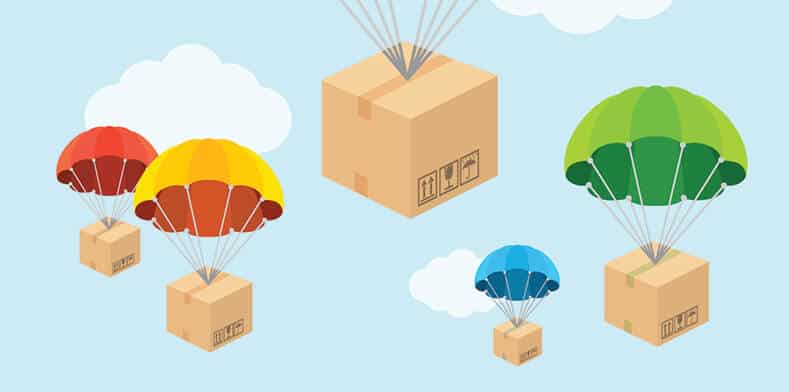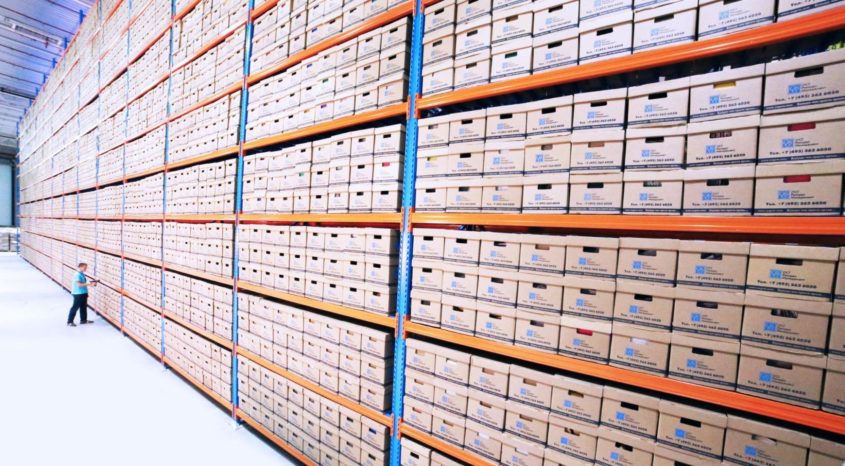What is dropshipping?
In short, dropshipping is a fulfilment method whereby instead of sending the customer an item from your inventory stores, you instead forward the order or shipment as a request to a vendor or manufacturer. They will send the item to the customer on your behalf, usually with your branding (so the customer has no idea the item didn’t come from your shelves!), and then will bill you directly.
When it comes to dropshipping, there are two ways that you can get involved. You may be acting as the retailer, passing the order onto your supplier for shipping, or you may be the dropshipper yourself, holding the stock, receiving the orders and shipping the items on behalf of another retailer. For the purposes of this article, I will focus on the scenario whereby you are the retailer using a dropshipper to help you get your goods in front of customers.
Whether it’s being used as your business’ core fulfilment method, a lifeline for when stock runs low, or a means to test a new product line, dropshipping is something that we’re seeing more and more of as the years go by, and retailers seek more automated business models.
Pros of Dropshipping
Many of the pros of dropshipping centre around how easy it is to get set up with it, and the ability to cut costs in some key areas of your retail business. Let’s consider these pros of dropshipping:
1. There’s no need to buy inventory upfront or store it
The effect of dropshipping is that you never touch the product; meaning that you don’t need to buy the inventory upfront or facilitate its storage, package it or ship it. As such, you could use it to try out new products that you are not 100% convinced of yet, or use it as your fallback in case you accidentally sell more than you have stored in the warehouse.
2. Easy to get setup
Many businesses actually start off with a pure dropshipping model, as it’s easier to get up and running, and you don’t have to worry about where to store your goods. Once your niche is defined, you will need to find a supplier that is able to offer you a promising dropshipping service. You may choose to begin your search on Alibaba.com or via Google, or you may even know someone who is already able to offer you this service. Next, comes an agreement on pricing, ensuring you’re not undercutting the retail side of your business (if relevant) and still making a profit despite the wholesaler’s fees. Now the fun begins – advertise and promote your new venture! It really is very easy to get set up with dropshipping, especially when compared with selling via retail sales channels alone.
3. Low overhead costs
As you’re not purchasing inventory, or managing a warehouse, your overhead expenses can be quite low. As you grow, it’s likely these costs will increase, but will still be very low in comparison with a more traditional brick-and-mortar or online store.
4. Flexibility and a wide array of products
A dropship business can of course be managed from anywhere in the world, offering you flexibility in where you work, or where your team is located. This can be great if you wish to outsource your labour to the overseas market. Equally, you also have flexibility over which products you can sell. You’re simply listing what other suppliers have to sell, allowing you to test out what works with your customers and what doesn’t work so well.
5. Easier to grow your business
In traditional businesses, if your sales double, you and your team do double the work. But in a dropshipping business, it’s your suppliers that are bearing the brunt of increased volumes and order processing. Therefore, there’s no hindrance to growing as a business as you don’t have to go out and hire 10 more employees. Instead, you can continue functioning relatively normally as a business, whilst your suppliers do the hard work behind the scenes.
Cons of Dropshipping
Dropshipping can be an easy and great way to start up or grow your business, but as with anything, there are consequences involved too:
1. Can be more expensive than traditional retail
What’s not to love? Well, all of this comes at a price. Dropshipping’s biggest financial drawback is the lower margins, as suppliers will often charge a premium to brand up their packages with your desired branding. This is something you will need to seriously consider in your planning: do you increase your prices, potentially scaring away new or loyal customers? Or should your margins take a bit of a hit at first, before you have the loyal following behind you, allowing you to slowly increase your prices over time?
2. Limited control over quality and branding
Aside from the costs involved, the real killer for some merchants is damage control, by which I mean playing the go-between on product or shipment quality issues. Running between your company and another supplier (or multiple) is not only a lot of extra work for you and your team, but can also cause issues with customer satisfaction, which brings us nicely onto…
3. Satisfying customers becomes harder than it needs to be
Trying to handle customer service issues as an in between can get stressful, as you don’t have full control. Shipping updates can be hard to give, especially if the supplier has a few warehouses scattered around, each shipping a part of the order, arriving at different times, via different couriers.
4. Tracking inventory can be tough
When stocking your own products, tracking inventory is really easy to do (especially with an integrated retail management platform, like Brightpearl). But as soon as you start introducing multiple warehouses (managed by other companies), keeping an eye on stock can be tough to do. It’s possible to use EDI to connect with other supplier’s systems, but this is not always possible – what if your supplier doesn’t have this technology in place? In these cases, it’s best to have a really solid relationship with your supplier and regular updates from them so that you know how many items you can sell to your customers, or whether your customers need to wait for more stock to arrive with your suppliers before receiving their deliveries.
5. Complexities with shipping can occur
We’ve already discussed one complexity, such as the possibility of one customer order being shipped from multiple suppliers, at different times, via different couriers. But what about shipping costs? When working with a number of suppliers, it can be difficult to keep on top of how much shipping each company is charging you, and thus, how much you should charge your customers (without scaring them off). Be sure to keep an eye on this – either you should increase your shipping prices accordingly, or include some of the costs in the product price so that your margins don’t take too much of a hit.
How can Brightpearl Help?
With Brightpearl in place as your order management and accounting solution, you can adopt any level of balance between internal fulfilment or dropshipments; you can test the water, move to a 100% dropship model for certain channels or territories, or even have it automate everything entirely. Many of our customers using a hybrid model of internal and drop-shipped fulfilment have gone one step further and represent their dropshipper’s stock via a virtual warehouse in Brightpearl. This means their sales teams can see what stock is available when internal supplies are empty, meaning they never miss a sales opportunity, or the ability to impress customers with their knowledge.
If you’ve decided that Brightpearl may be a good addition to your dropshipping ventures, then I’ve detailed what a typical dropship workflow in Brightpearl looks like:
- A sales order is created (either as a manual phone order, automatic online sales order or POS order).
- Inventory is automatically allocated based on your stock levels, reducing the availability on all connected sales channels.
- This order is fulfilled to a purchase order and sent to your supplier.
- Your supplier lets you know the items have been sent and sends you an Invoice.
- At this point, your settings will dictate whether your purchase order will be marked as shipped upon the purchase invoice being received, or the items being received.
- All associated sales orders can now also be marked as shipped.
Whenever an order is processed in this way, Brightpearl automatically sets it as a dropship order and adds a parachute symbol to signify it’s a dropship. This means your team can spot these orders at a glance, which is useful if their order processes are slightly different for these orders versus other ones.
Sound good? Book a demo today and see how Brightpearl and dropshipping could fit into your business.
Dropshipping – Common FAQs
How does dropshipping work?
Dropshipping is a retail fulfilment method where a business doesn’t keep the products they sell in stock. Instead, when a store sells a product, they then purchase the item from a third party and have it shipped directly to the customer. As a result, the seller doesn’t have to handle the product directly. The key benefit is that it eliminates the need for the business to maintain an inventory or manage a warehouse, reducing overhead costs significantly.
How do you find dropshipping suppliers?
Finding dropshipping suppliers requires lots of research. Popular methods include:
Google: Simply search for the product type you want to sell and reach out to brands directly.
Online Directories: Websites like Zendrop, SupplierHQ, Syncee or Spocket offer either a list of brands you can reach out to, or even the option to freely use these suppliers directly.
Manufacturer Contact: Directly contact the manufacturer of the product you want to sell and either ask if they offer dropshipping or ask for a list of its wholesale distributors. You can then contact these distributors to see if they dropship and inquire about setting up an account.
Trade Shows and Industry Networking: Attending trade shows relevant to your market is an excellent way to find and establish contact with potential suppliers.
Is dropshipping right for my business?
Dropshipping suits businesses looking for low startup costs and less hands-on involvement in logistics. It’s ideal if:
- You have limited capital for inventory.
- You want to offer a large number of products without the need for large storage spaces.
- You want to test out new markets or products without investing in inventory.
- You’re comfortable with thinner profit margins due to higher competition and lower control over shipping and product quality.
Dropshipping is less suitable if you aim to build a brand with exclusive products or if you want full control over the supply chain and customer experience.
Is dropshipping legal?
Dropshipping is a legal business model. However, research is crucial to ensure compliance with local and international laws. This is especially important when you aim to sell internationally and when importing products. Important considerations include:
- Ensuring your suppliers are legitimate and sell authentic, non-counterfeit products.
- Adhering to tax regulations in your jurisdiction and any regions you sell to.
- Understanding and complying with consumer protection laws, which include providing accurate product descriptions and adhering to shipping and return policies.




